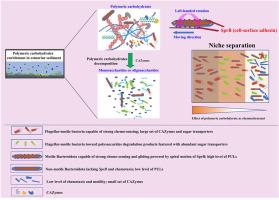Degradation of polymeric carbohydrates coupled with cellular motility driving microbial niche separation in the Pearl River Estuary surface sediment
IF 6.3
2区 环境科学与生态学
Q1 ENVIRONMENTAL SCIENCES
引用次数: 0
Abstract
Estuaries are key areas for organic carbon cycling, where polymeric carbohydrates are abundant and chemically diverse. The recycling of these polymers by microbes depends on a variety of carbohydrate-active enzymes (CAZymes). However, it remains unclear whether other gene traits, particularly those related to cell motility toward polymeric carbohydrates, are intertwined with carbohydrate depolymerization and niche specialization in estuarine sediment soils. In this study, estuarine sediments were incubated with four prevalent polymeric carbohydrates (laminarin, fucan, cellulose, and chitin) under anaerobic conditions. Based on metagenomic analysis, we identified potential responses to the degradation and utilization of polymeric carbohydrate substrates from the perspectives of CAZymes and sugar transporters. The analysis of metagenomic gene data also revealed a positive correlation between chemotaxis and the abundance of CAZymes genes. Furthermore, metagenomes-assembled genomes (MAGs) that exhibited higher abundance in polysaccharide-treated samples compared to controls also featured elevated copies of genes involved in polysaccharide utilization loci (PULs), chemotaxis, as well as those associated with flagellar or gliding movement. SprB and CTDs associated with gliding proteins genes are essential for type IX secretion system-mediated secretion of CAZymes and gliding motility in Bacteroidota. The enhanced potential for mobility, coupled with the ability to degrade polymeric carbohydrates, may enable these bacteria to exploit nutrients beyond carbon sources, thereby potentially broadening their ecological niches.

珠江口表层沉积物中高分子碳水化合物降解与细胞运动驱动微生物生态位分离
河口是有机碳循环的关键区域,那里的聚合碳水化合物丰富,化学成分多样。微生物对这些聚合物的再循环依赖于各种碳水化合物活性酶(CAZymes)。然而,目前尚不清楚其他基因性状,特别是那些与细胞对聚合碳水化合物的运动有关的基因性状,是否与河口沉积物土壤中的碳水化合物解聚和生态位特化有关。在本研究中,在厌氧条件下,将河口沉积物与四种常见的聚合物碳水化合物(层膜聚糖、岩藻聚糖、纤维素和几丁质)孵育。基于宏基因组分析,我们从酶和糖转运体的角度确定了对聚合物碳水化合物底物降解和利用的潜在响应。宏基因组基因数据分析也显示趋化性与CAZymes基因丰度呈正相关。此外,与对照组相比,多糖处理样品中宏基因组组装基因组(MAGs)表现出更高的丰度,并且与多糖利用位点(PULs)、趋化性以及与鞭毛或滑翔运动相关的基因拷贝数也有所增加。与滑翔蛋白基因相关的SprB和CTDs对IX型分泌系统介导的CAZymes分泌和滑翔运动至关重要。增强的移动性潜力,加上降解聚合碳水化合物的能力,可能使这些细菌能够利用碳源以外的营养物质,从而潜在地扩大其生态位。
本文章由计算机程序翻译,如有差异,请以英文原文为准。
求助全文
约1分钟内获得全文
求助全文
来源期刊

Journal of Environmental Sciences-china
环境科学-环境科学
CiteScore
13.70
自引率
0.00%
发文量
6354
审稿时长
2.6 months
期刊介绍:
The Journal of Environmental Sciences is an international journal started in 1989. The journal is devoted to publish original, peer-reviewed research papers on main aspects of environmental sciences, such as environmental chemistry, environmental biology, ecology, geosciences and environmental physics. Appropriate subjects include basic and applied research on atmospheric, terrestrial and aquatic environments, pollution control and abatement technology, conservation of natural resources, environmental health and toxicology. Announcements of international environmental science meetings and other recent information are also included.
 求助内容:
求助内容: 应助结果提醒方式:
应助结果提醒方式:


